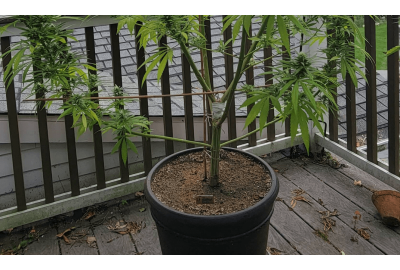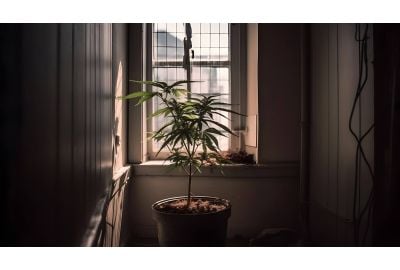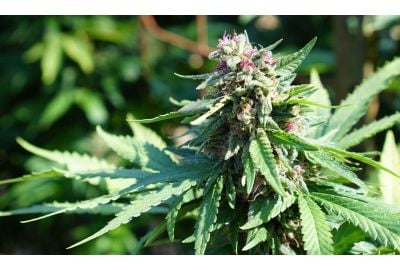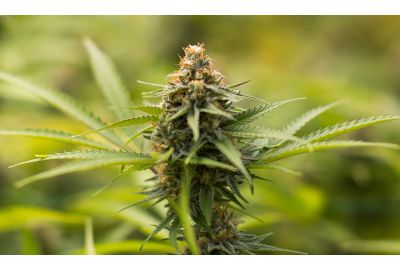Flushing Cannabis: When, Why, And How To Flush Your Plants
Flushing cannabis is crucial for fixing nutrient lockouts issues. It’s optional to flush pre-harvest or between nutrient exchanges.
While many growers believe a pre-harvest flush unlocks all the flavors of the flower, there's no scientific evidence to prove this. Many stoners claim weed in a joint that's not flushed appears harsher than normal, and you can taste the nutrients, especially in a vaporizer.
Though it's not a priority, you can try marijuana that's properly flushed compared to one that's not to and see if it makes a difference. Is the weed more enjoyable or not? If you agree that it is, then read on.
We'll dig deep into why it's important and how to flush marijuana plants the right way, for whatever reason. Let's roll.
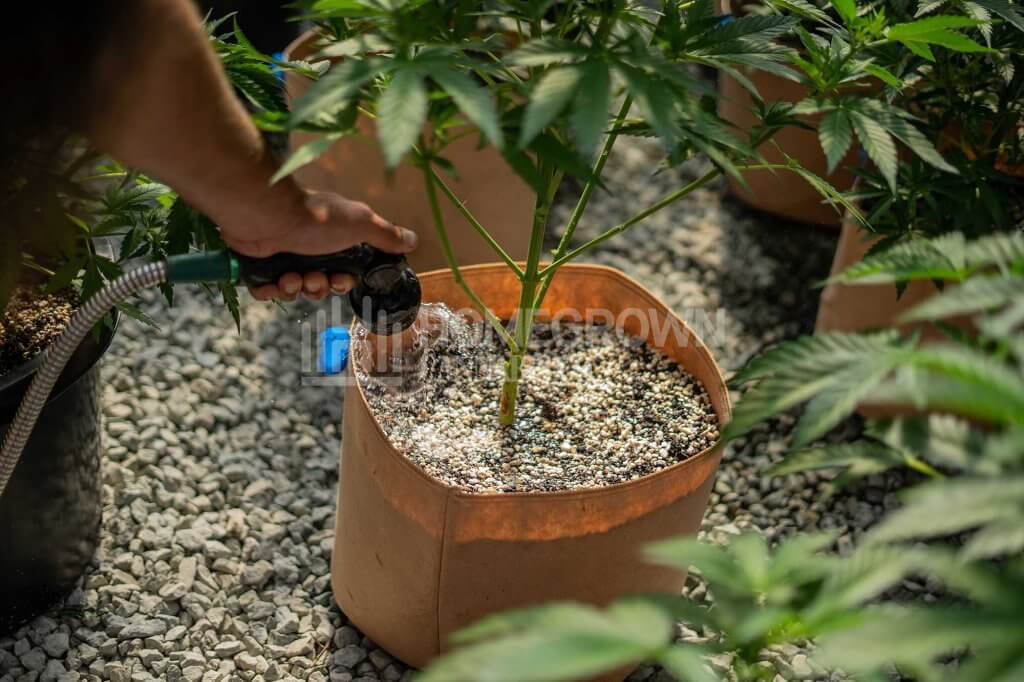
What is cannabis flushing?
Flushing cannabis plants doesn't literally mean to flush them down the toilet. That's just maniacal—although many have done so due to unforeseen circumstances. Flushing weed means removing nutrients in the medium (hydro/soil) it’s grown in.
Old-school growers say leeching, referring to a marijuana flush that purges out the residual nutrients of supplemental fertilizer. The weed absorbs the nutes, but you want them "washed" out or drenched out of the medium.
Flushing cannabis is straightforward—all you need is to water your plant with simple pH-balanced water instead of nutrient solutions. Checking pH isn't necessary for most local soft municipal drinking water, and the PPM is usually within range (30–400 PPM). The runoff water from the final flush in soil should be less than 1300 ppm.
It's advisable to let tap water that you’ll use to flush settle for a day or two, allowing for the chlorine in it to evaporate. Flushing solutions available at the grow store can help remove the salts in the soil even better—these are usually solvents to aid with a quick flush, but most growers don't find it necessary.
Why is flushing cannabis important?
Flushing cannabis is crucial for fixing nutrient issues. There's no scientific evidence to show that a final cannabis flush is essential. Some studies even argue about its benefits, outlining how the process could harm yields.
Many growers believe a final marijuana flush ensures your plant uses up all its stored sugars and absorbs everything in the medium. The result is sweeter and fatter buds.
Flushing weed tricks the plant into thinking it's dying, so it can predominantly focus on blooming. In this sense, flushing can be akin to how some growers give their plants 48 hours of darkness in the final days or add ice in the medium to replicate outdoor environments when winter is coming.
Some say they can't tell the difference between flushed and non-flushed weed. Many veterans argue that white ash is a sign of well-flushed weed. Unflushed weed ash burns slowly as if it's wet, even after drying the branches for long. The smoke could also be harsher, making you cough more than you alternatively would.
Flushing cannabis plants towards the end is debatable, but you can experiment by cultivating two similar strains and flushing one. You can also do a side-by-side final flush using plain water on one plant or with a sweetener, such as molasses or honey, on another.
Read our report on "flushing with molasses" to know more.
When to flush cannabis?
Flush cannabis plants if you ever experience any nutrient lockout or toxicity problems. It's not advisable to flush unless you see an issue.
It's all up to you whether you think flushing before harvest can enhance the quality of your buds. Many ganja farmers believe that it's even more important to do a final flush if you're cultivating with synthetic nutrients, such as in hydro.
Soil growers typically flush cannabis plants two weeks before harvesting, while those in hydro can cut this down to a week. Timing is key because if you flush too soon, you'll have cleansed an immature plant. Too late, with too little water or not frequently enough, then nutrient salts won't wash out.
When to start flushing?
Growers generally use plain water to flush cannabis for different reasons, but the length of time for each purpose is different. Here are the three main incentives for flushing any cannabis plant:
- Fix nutrient-based issues: Carry out a cannabis flush if your plant looks unhealthy or displays warning signs of nutrient lockout. You might see yellowing, burnt, clawing, or abnormally dark green leaves, showing signs of nutrient lockout.
Other symptoms include stunted growth or lack of vigor in a plant. Flush your growing medium, observe changes in new growth, then tweak the fertilizer ratios as seen fit.

- Finish the plants: Flushing before harvest reduces certain fertilizer flavors from your bud, making the smoke smoother and the weed tastier. Some growers apply bloom boosters to increase the yield, or sweeteners like molasses, claiming the smoke is better because of it.
During the final flush, you should start to see yellowing of the fan leaves and fading of the canopy—a good sign that nutrients are being depleted properly.
- Change nutrients when switching to flowering: Some growers like to flush cannabis as they shift from veg to flowering because the plant's nutrient needs change. Marijuana plants prefer nitrogen-based fertilizers during veg and phosphorus-based nutrients for plump buds during flowering.
Flushing weed isn’t harmful when you want to prevent the buildup of nutes from the previous stage. Though not recommended, flushing between different stages of growth can lead to a smoother transition.
The first reason for flushing cannabis is mandatory if the need arises, while the other two are optional.
When to flush autoflowers?
Realizing when to start flushing autos before harvest is tricky if you don't know your plant's start to finish time. Seek this type of info from where you got the auto seed.
Many people struggle with how to flush autoflowers since you don't really know when it switches from veg to flowering. The auto could switch after two or three weeks. It could take a few runs to understand when the auto you're growing requires the final flush.
It's all down to trial and error by observing when the first auto plant's ready for harvesting and using such information for your next grow of the same strain. Make it easy on yourself by purchasing seeds from a reputable seed bank like Homegrown Cannabis Co., where we provide detailed info on each of the genetics in our locker.
It's simpler to adjust based on prior growth if running the same genetics multiple times. Schedule your last feed to coordinate with the same auto strains you're cultivating. Good for you; flushing before harvest is all a matter of preference, and you can get away without it.
Without any prior info, you can flush autos when the trichomes turn from clear to cloudy. Better late than never.
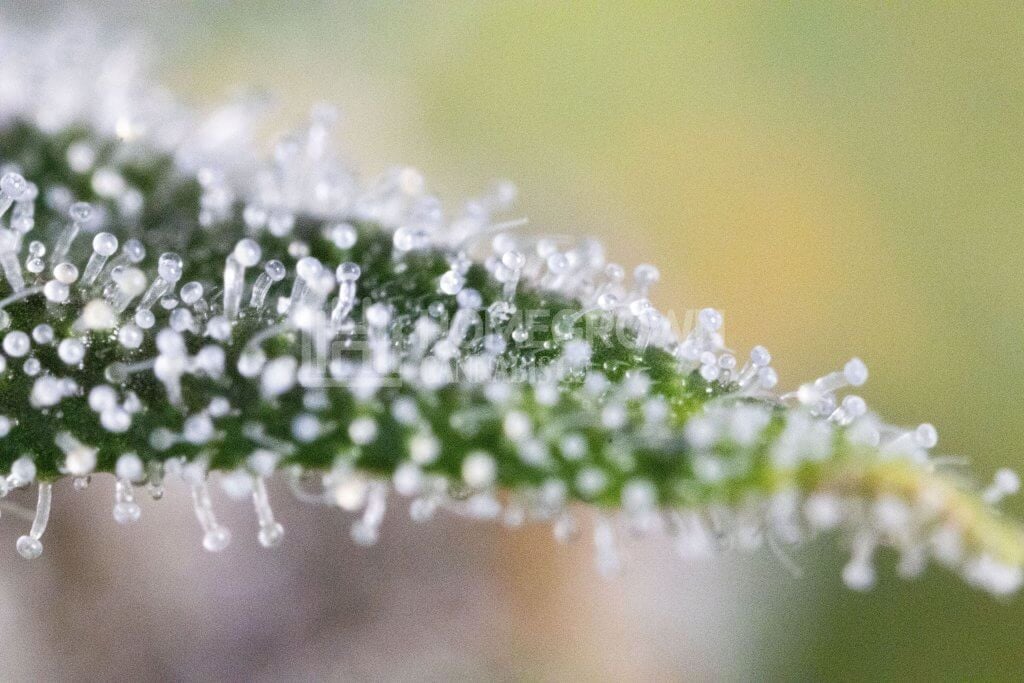
How to flush weed plants
You don't need any special tools or techniques to flush cannabis plants. All you need is to feed pure water to your plants instead of nutrients. If you'd like to be more specific, flush utilizing water with pH levels between 5.5 to 6.5 for hydroponics and 6 to 6.7 for soil.
How to flush your plants in soil
Most people simply use nothing but ordinary tap water for a marijuana flush, and this is okay. You can add some solvents, usually marketed as flushing agents, to aid in amending the soil.
Instead of nutrients, apply double the amount of water to your soil and let it drain out before adding to it again. You can go for two, up to no more than five, rounds of flushing using plain water on soil. Ensure the growing container has good drainage because you don't want the plant roots to sit in a puddle of water.
The runoff water after flushing weed grown in soil should be clear in the end, indicating room for your new feeding schedule or starve your plant in the end. To be more accurate, use an EC meter to measure the PPM.
Refrain from flushing super soil tailored to weed if you cannot replenish it with microbial life found in good manure.
How to flush hydroponic plants
Flushing cannabis plants in hydro is a simple matter of switching from a nutrient solution to plain water. A final flush for hydro is even more important because of the synthetic nutrients you're feeding to your plant. Excess minerals not washed out can result in weird and harsh tasting buds.
Start by feeding the plant half the strength of the nutrient solution if changing to a new feeding schedule. Increase the strength to what’s recommended after a week to avoid shocking your plant.
How to flush autoflowers
Flushing cannabis autos is the same as in photoperiod plants. However, it would be best to be more accurate about when the auto is nearing harvest time to make the final flush.
Look at the trichomes and pistils if you don't know when to carry out a final flush on your auto. The trichomes should turn cloudy, and pistils could have darkened. Go ahead and start flushing cannabis plants at such a point in their life cycle.
Best way to flush your plants
Simply flush cannabis plants with plain water. You don't need extra solvents to muster a cleaner and better smoking product. You can get more specific by using pH-balanced water. Use tap water because its pH isn't so bad, and the PPM usually falls within the ideal region for flushing cannabis, be it soil or hydro.
Many growers recommend not to start flushing before harvest for more than two weeks because that could hurt your yields. Some even flush for up to 3 weeks by choice.
Some flushing solutions expedite the leaching process, but these are not essential unless you're very late into flower or face a debilitating nutrient lockout issue. You're flushing the right way if you've cut off your nutrients a week or two before harvest and are watering weed plants with large volumes of plain, pH-corrected water.
How long to wait after flushing can you harvest
Harvesting depends on your plant's due date. Understand what strain you're growing and how long they take to flower. The plant may look or smell ready when they are not. Knowing the flowering time for your genetics is great because you'll also know when to start flushing.
It's important to discern whether you have a six, eight, or 11-week flowering strain. This information is key to flushing your cannabis at an optimum time.
Secondly, look at your trichomes to know when to start flushing before harvest. Check whether the trichomes have a nice amber-like complexion to them. The plants aren’t ready to chop if the trichomes are clear, and you can see straight through to the sugar leaves.
If the trichomes are turning milky, it means your weed is almost ready, but it's not there yet. This appearance indicates an ideal time to start the cannabis flush.
Pay attention to your plant, and the trichomes turning from clear, milky to amber should tell you when your plant is ready for harvesting. It's recommended that you reap your buds when about 70% of the trichomes are amber, with the rest cloudy.
Don't get scared too much if a final cannabis flush goes on for up to 3 weeks, which is more than enough time for cloudy trichomes to turn to amber. The only concern is that it might hurt the final yield slightly.
Things to know about flushing weed
Flushing is to stop giving your plants nutrients for a while by just feeding them nothing but pH-balanced water. You flush cannabis because:
- There's an excess of salts or nutrients buildup in your medium
- You want a smooth transitioning from veg to flower
- You want an added advantage of sweeter buds by flushing towards the end
The first reason for flushing weed is necessary to save it from impending doom. The latter incentives are all down to preference and debatable since you'll still have a healthy lady plant anyway.
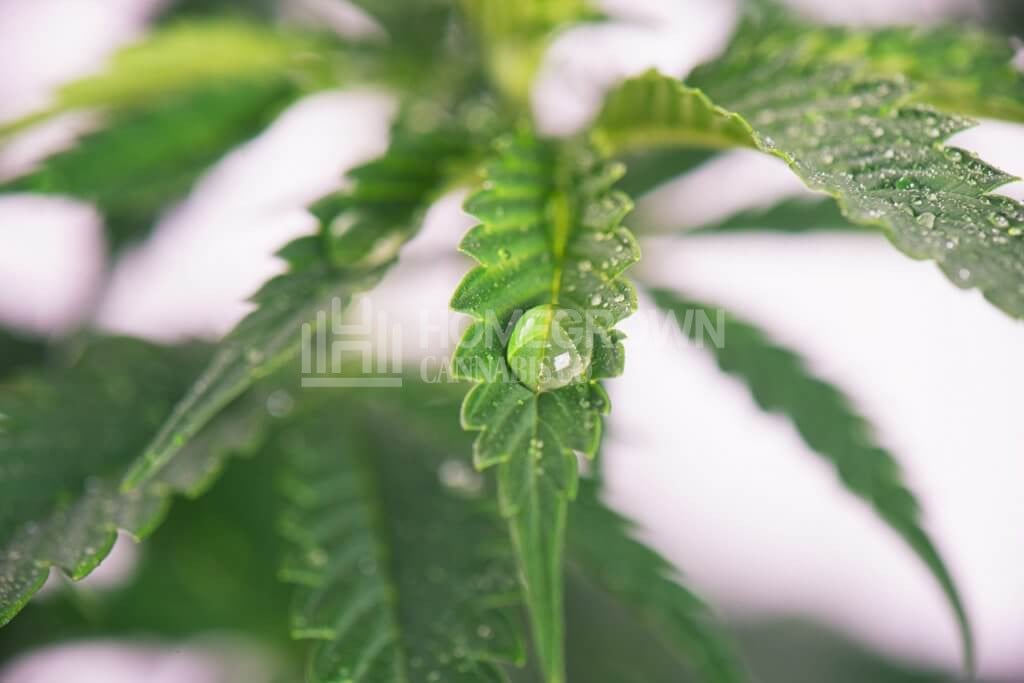
FAQs about flushing cannabis
Here are answers to some of the most common questions regarding flushing cannabis plants.
How many times should I flush my plants before harvest?
How frequently you flush cannabis plants depends on your situation. For example, you may face nutrient lockout issues more than once or never. Every nutrient lockout problem warrants a flush. You may want to flush as you make the switch from veg to flowering.
You could also make a final cannabis flush for sweeter buds. Look at the plant's behavior and gauge whether you need to flush them due to nutrient lockouts because that's the only time you must.
When should I flush to harvest
A standard final cannabis flush can take 7 to 10 days but can go on for up to two weeks, especially in soil. Don't start flushing too early because you may end up killing your plant before the buds are ripe. Flush too late, and you'll end up with harsh smoking buds by the time they're ready.
There are a few simple methods for knowing when it's time to flush. For one, start a marijuana flush based on what week of flower your plants are in. For example, if your cannabis plant takes eight weeks to flower, and you want to do a two-week flush, then you'd start your flush at week six. That's two weeks before your plant is estimated to finish, to complete the process on time.
Check with the breeder to tell you the standard flowering times of your seeds or clones.
Even though the timing is easy, it's not always the most accurate. The strain's flowering time may vary depending on the plant phenotype. To be more precise, check the trichomes using a jeweler's lighted loop. You can begin flushing weed plants as soon as you see the trichomes change from clear to cloudy.
While flushing cannabis, you'll notice the leaves start to yellow, which is perfectly fine. This change is a sign that the plants are being purged of their extra nutrients. Most of the larger fan leaves could be yellow, but the smaller sugar leaves full of trichomes should remain green.
Does flushing really do anything?
Yes and no. Probably you're asking this for flushing before harvest because you must flush if witnessing nutrient lockouts or toxicity issues to save your plant from dying prematurely.
There's a huge argument against a final flush, as present studies show the practice doesn't help with anything and could harm your plant’s yields. Many marijuana connoisseurs claim the opposite.
Have you ever smoked weed that burns slowly, with harsh smoke, or even causes headaches? Sure you have, and these are all things many cannabis connoisseurs say a final marijuana flush before harvest helps rectify. If that's the case, then the slightly lower yields from plants starved towards the end shouldn't be much of a concern.
Some people even argue a terminal cannabis flush increases the bud size because the plant's triggered to boost trichome production.
Many stoners claim to feel an excess of residual nutrients left behind in the final product from plants that are not flushed. A marijuana flush supposedly makes the plant consume all its reserved sugars and residual nutrients stored inside it. Reduce the surplus nutes by flushing before harvest and see if it does anything different to your bud.
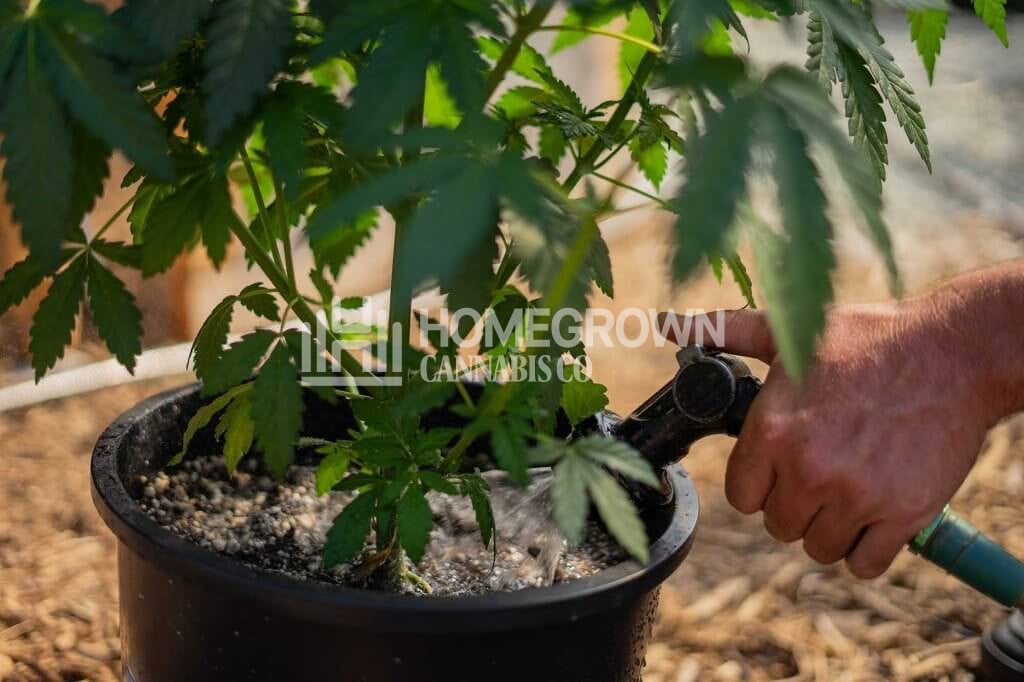
To flush or not to flush
Here’s what we’ve learned about when to flush cannabis plants:
- You must flush to fix nutrient lockout issues.
- Making a final flush is all up to you, and you can save money on nutrients doing so.
Check out our perfectly balanced marijuana nutrients that should serve the needs of your marijuana plants from seedling, vegetative, flowering, to late flowering stages. You'll hardly ever face any nutrient lockouts if using our solutions in the right PPM. Feel free to talk to us if you have any more questions about flushing cannabis or any of our products.
About the author: Parker Curtis
Parker Curtis has around a decade of cannabis-growing experience, specialising in soil-less and hydro grows. He’s mastering outdoor, greenhouse, and indoor grows.
